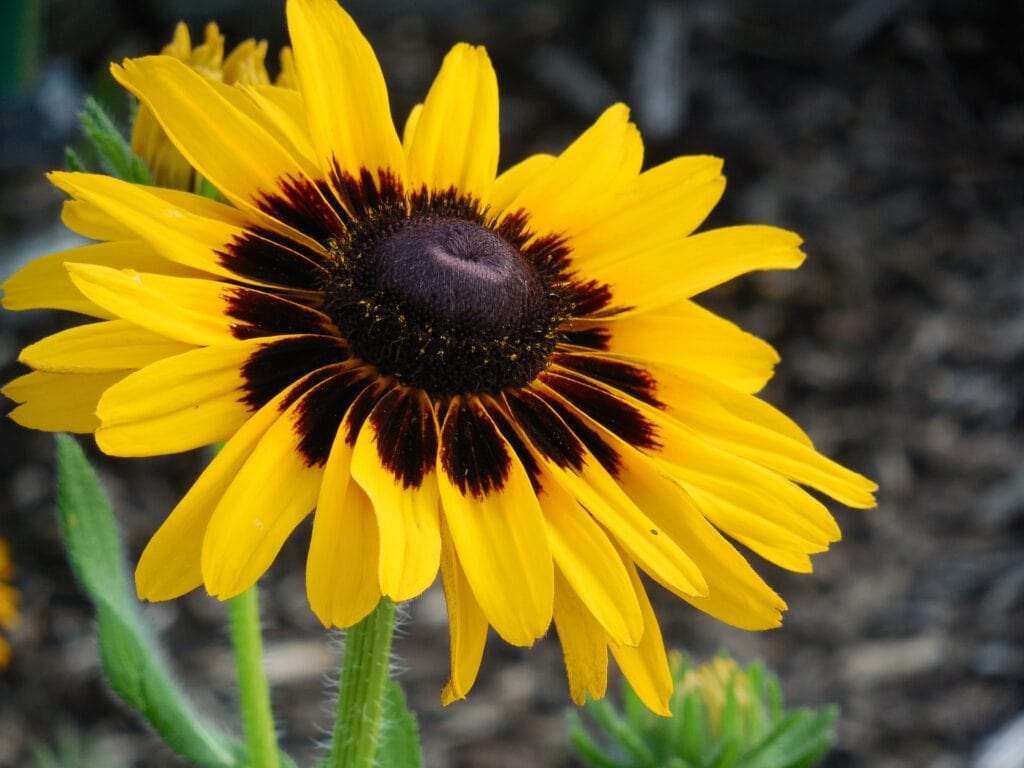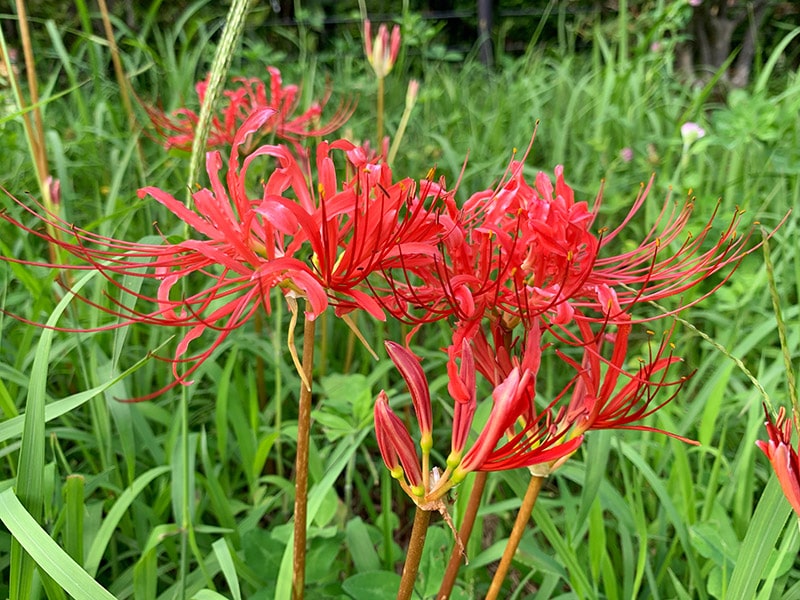12 Wildflowers that Grow in Arkansas: Identification Guide (With Pictures)
-
Brooke Billingsley
- Last updated:

Arkansas is called the Natural State, and if you’ve spent much time in Arkansas, you fully understand why. This state is full of natural beauty from all manner of flora and fauna, and wildflowers are one of the most lovely and eye-catching types of flora in the state.
Wildflowers come in all colors, shapes, and sizes, and they can be found everywhere from mountains and woods to highway medians. There are over 600 species of wildflowers in Arkansas, so it’s impossible to list them all, but here are some of the most beautiful wildflowers that you might spot around the state of Arkansas.
The 12 Wildflowers That Grow in Arkansas
1. Black-eyed Susan

| Color: | Yellow and black |
| Size: | 12–36 inches |
The Black-eyed Susan is one of the most immediately recognizable wildflowers in the state of Arkansas. With bright yellow, daisy-like blooms, these flowers are set apart by their dark black center.
These plants can reach up to 3 feet in height, allowing them to be easily spotted, even if you’re speeding past in a car. They bloom from June to August, and they are a favorite of pollinators, but not to deer—instead being considered deer resistant.
2. Downy Phlox

| Color: | Pale pink to lavender |
| Size: | 12–24 inches |
Downy Phlox is a mounding perennial that can reach up to 24 inches in height. It produces beautiful flowers that can be found in pale pink, lavender, and everything in between.
The showy flowers grow in clusters at the end of long stems, and this plant is a host plant for the critically imperiled Phlox moth. It also attracts other pollinators, including butterflies and hummingbirds. This plant blooms in April and May.
3. Purple Coneflower

| Color: | Purple |
| Size: | 36–42 inches |
Purple Coneflower is somewhat similar in appearance to the Black-eyed Susan, but its blooms are a pleasing shade of light purple. As the name implies, the flowers have a tall, cone-shaped center that is typically brownish in color.
These herbaceous flowers of this plant bloom in mid to late summer, and some will even bloom again in late fall. For backyard gardens, the Purple Coneflower is the most popular Echinacea variety.
4. Pale Purple Coneflower

| Color: | Light purple |
| Size: | 24–36 inches |
The Pale Purple Coneflower may sound similar to the Purple Coneflower, and while they both belong to the Echinacea family, they are two separate species of flowers.
If you looked at them side by side, you’d easily see that the daisy-like petals of the Pale Purple Coneflower are thinner and slightly longer than the petals of the Purple Coneflower. Otherwise, they are similar in appearance, although the Pale Purple Coneflower is slightly shorter at its maximum height.
5. Carolina Larkspur

| Color: | White, periwinkle, light blue |
| Size: | 12–36 inches |
Carolina Larkspur is an herbaceous perennial that has beautiful flowers that bloom all the way up a long stem. The flowers can be spotted in a variety of shades of white and blue, and they tend to bloom in June and July.
These plants can reach up to 3 feet in height, and they enjoy growing in rocky, dry soil. In the winter, you can spot Carolina Larkspur staying close to the ground but continuing to produce rosettes of leaves.
6. Spider Lily

| Color: | White |
| Size: | 36 inches |
The Spider Lily is an unusual and uncommon plant that may be mistaken for its cousin, the Red Spider Lily. However, the visual differences between these two plants are staggering because of the unusual blooms of the Spider Lily.
These white flowers feature a rounded center with long, thin petals protruding from it. These flowers can reach up to 7 inches in diameter, and they have a fragrant and pleasant smell.
7. Cardinal Flower

| Color: | Red |
| Size: | 24–48 inches |
The Cardinal Flower is named for its beautiful, cardinal red flowers. These plants can reach up to 4 feet in height, but the flowers usually grow on stems that are only about 8 inches tall. The flowers grow all along the length of the flowering stem, and they bloom for one or more months in late summer, sometimes even blooming into October. They are also a favorite of hummingbirds.
8. Goldenrod

| Color: | Goldenrod yellow |
| Size: | 48–72 inches |
Goldenrod plants produce tons of tiny flowers, giving each stem a fluffy look. These flowers are a bright yellow color known as goldenrod, so it’s obvious where the name and color of the Goldenrod plant collide.
These plants can reach up to 6 feet in height, so it’s impossible not to miss these tall, brightly colored plants on the side of the road. They bloom from July through September, and the flowers of the Goldenrod plant are a favorite of many pollinators, including those that are critically endangered.
9. Ox-eyed Daisy

| Color: | White and yellow |
| Size: | 12–36 inches |
The Ox-eyed Daisy features a classic daisy-shaped flower with white petals and a sunshine-yellow center. The plant can reach up to 3 feet in height, and the flowers bloom from May through July.
Unfortunately, the Ox-eyed Daisy is a highly invasive plant that is a perennial, so it comes back stronger year after year. It is commonly used in flower beds and seed mixtures, which is furthering the spread of this invasive plant species.
10. Arkansas Beard Tongue
| Color: | White and lavender |
| Size: | 24 inches |
The Arkansas Beard Tongue is, as the name implies, an Arkansas native. It has historically been considered part of the Snapdragon family, but it is now considered to be part of the Plantain family.
This plant can exceed 2 feet in height, and it blooms beautiful flowers that are white with delicate lavender streaking through them. The flowers are only about ¾-inch in length, but there are multiple flowers on a stem. The flowers bloom from April through June.
11. Mexican Hat

| Color: | Red, yellow, and brown |
| Size: | 24–36 inches |
The Mexican Hat plant is a native species that produces yellow flowers with red accents. Sometimes, the petals are solid red or yellow. The center of the flower is cone-shaped, and it’s sometimes called the Prairie Coneflower. However, it isn’t related to the Echinacea Coneflowers. This plant can reach up to 3 feet in height, and it has a long bloom time that lasts from June through October.
12. Queen Ann’s Lace

| Color: | White |
| Size: | 12–48 inches |
Queen Ann’s Lace is an introduced species, but it is well-established in the state of Arkansas. Some states do consider this plant to be an invasive species, but it does provide a reliable food source for some wildlife.
It is the ancestor of the modern-day carrot plant, and you will sometimes see it referred to as Wild Carrot. It produces bunches of beautiful, tiny, white flowers at the end of long, thin stems.
Conclusion
Arkansas is filled with a wide variety of beautiful native and non-native wildflowers. You’ll be able to find them just about anywhere you go in the state between the months of March and the end of October.
It is important, though, that if you are interested in keeping a home garden that you ensure that any seeds you plant are native Arkansas species. Otherwise, you may be unintentionally adding to the problem of introducing invasive species that can compete with native species for resources.
Featured Image Credit: Skitterphoto, Pixabay
Contents

